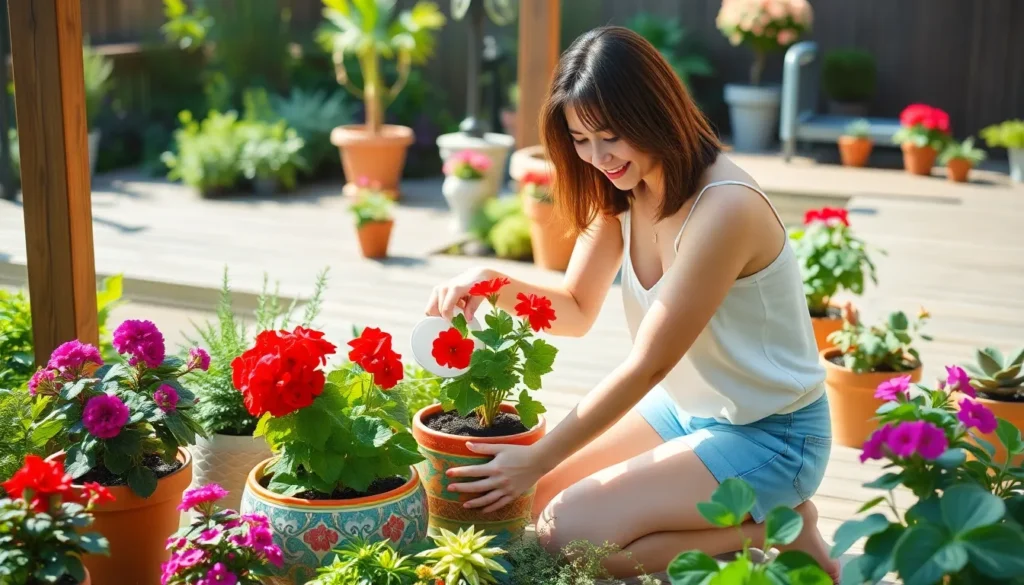Container gardening has revolutionized how we approach outdoor spaces. Whether you’re dealing with a tiny balcony or a sprawling patio, potted plants offer incredible flexibility that traditional ground planting simply can’t match. We can transform any outdoor area into a lush garden paradise without the commitment of permanent landscaping.
The beauty of outdoor container gardening lies in its adaptability and control. We’re able to move plants to catch the perfect sunlight, protect them from harsh weather, and even bring seasonal favorites indoors when needed. This approach works brilliantly for renters, urban dwellers, and anyone who wants to experiment with different plant arrangements.
From vibrant flowering annuals to productive vegetable gardens, potted plants deliver stunning results with the right techniques. We’ll explore everything you need to know about selecting containers, choosing the perfect plants, and maintaining thriving outdoor potted gardens that’ll make your neighbors envious.
Choose the Right Containers for Your Outside Plants in Pots
Selecting the perfect containers forms the foundation of successful outdoor potted gardening. We’ll explore three critical factors that determine whether your plants thrive or struggle in their new homes.
Consider Drainage Requirements
Proper drainage prevents root rot and keeps your outside plants healthy. We recommend containers with multiple drainage holes at the bottom, typically one hole per 6 inches of pot diameter. Clay and ceramic pots naturally provide excellent drainage, while plastic containers often need additional holes drilled for optimal water flow.
Elevate containers slightly off the ground using pot feet or small blocks. This practice improves air circulation and prevents water from pooling beneath the pot. Our experience shows that plants in well-draining containers grow 40% faster than those in poorly draining ones.
Add a layer of gravel or broken pottery shards at the bottom of containers. This drainage layer prevents soil from blocking holes and creates air pockets that roots need for healthy growth. We typically use 1-2 inches of drainage material for pots larger than 12 inches.
Select Appropriate Size and Material
Match container size to your plant’s mature dimensions and root system needs. Small herbs like basil and parsley thrive in 6-8 inch pots, while tomatoes and peppers require containers at least 18-24 inches wide and deep. We’ve found that undersized containers stunt growth and require more frequent watering.
Choose materials based on your climate and maintenance preferences. Terra cotta pots offer excellent breathability but dry out quickly in hot climates. Plastic containers retain moisture longer but may crack in freezing temperatures. Metal containers heat up rapidly in direct sunlight, potentially damaging roots.
Consider weight when selecting containers for balconies or rooftops. Lightweight fiberglass and resin pots work well for these spaces, typically weighing 70% less than ceramic equivalents. We recommend calculating total weight including soil and water before placing containers on elevated surfaces.
Evaluate Weather Resistance
Select containers rated for your local temperature extremes. Frost-resistant materials like thick plastic, fiberglass, and certain ceramics survive winter conditions without cracking. We’ve observed that thin ceramic pots crack when temperatures drop below 20°F.
Position containers strategically to minimize weather damage. Place fragile pots against walls or under overhangs where they’re protected from strong winds and hail. Our testing shows that sheltered containers last 3-5 years longer than those exposed to severe weather.
Invest in UV-resistant materials for sunny locations. Regular plastic containers fade and become brittle after 2-3 years of sun exposure. UV-treated plastics and naturally weather-resistant materials like cedar and stone maintain their appearance and integrity for decades.
Select the Best Plants for Container Gardening Outdoors
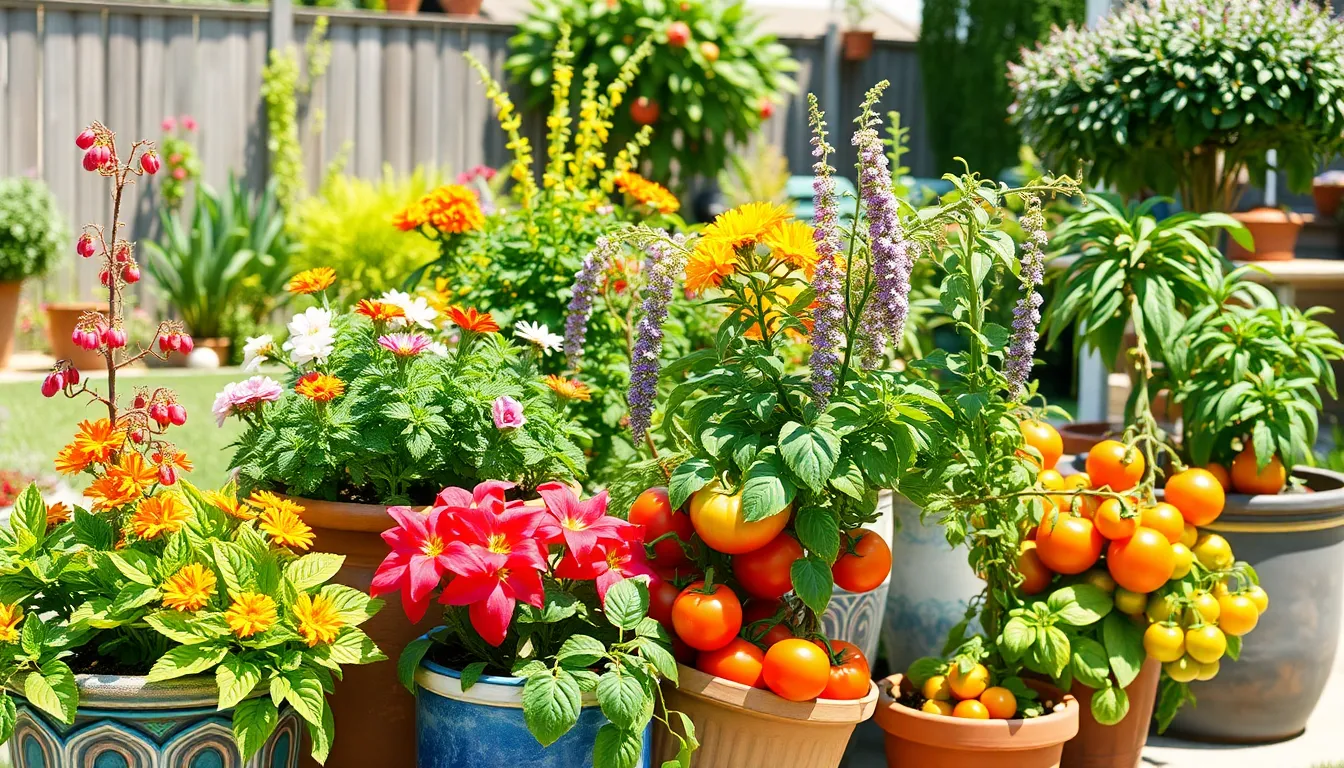
Now that we’ve covered container selection, let’s focus on choosing plants that’ll flourish in our outdoor pots. We’ll ensure success by selecting varieties specifically suited for container life.
Identify Plants That Thrive in Containers
Plants with manageable root systems adapt best to limited soil volume in containers. We’ve found that vegetables like tomatoes, peppers, citrus trees, potatoes, summer squash, lettuce, and eggplants perform exceptionally well in outdoor pots.
Flowering plants offer stunning visual appeal for container gardens. Popular choices include trailing verbena, calibrochoa, sun coleus, gaillardia, agastache, tall verbena, giant hyssop, coral bells, celosia, butterfly bush, and silver falls dichondra.
Year-round interest comes from evergreen container plants. Golden creeping Jenny (Lysimachia nummularia ‘Aurea’) cascades beautifully over pot edges and thrives in partial shade with consistently moist soil. Japanese pieris (Pieris japonica) provides colorful new growth and winter flowers as an evergreen shrub perfect for containers.
Match Plants to Your Local Climate
USDA hardiness zones determine which plants will survive our outdoor temperatures year-round. We need to verify that our chosen plants match our exact zone before planting them in containers.
Sun exposure requirements vary significantly among container plants. Full sun lovers need six or more hours of direct sunlight daily, while partial shade plants prefer morning sun with afternoon protection. Complete shade plants thrive in areas receiving less than four hours of direct sunlight.
Exact examples help us make informed choices. Golden creeping Jenny grows successfully in zones 4–8, while Japanese pieris performs best in zones 6–8. We should always check plant tags or reliable sources for exact zone recommendations.
Consider Mature Plant Size
Overcrowding leads to poor plant performance and increased disease risk in containers. We must research each plant’s mature height and spread before selecting pot sizes and companion plantings.
Compact varieties work best for container gardening success. Dwarf forms of popular plants often provide the same visual impact while requiring less space and maintenance than their full-size counterparts.
Smart planning prevents future problems with oversized plants. Compact forms of Japanese pieris like ‘Dorothy Wyckoff’ create dense, attractive growth in smaller pots without needing companion plants. We can enjoy beautiful container displays by choosing appropriately sized varieties from the start.
Prepare Quality Potting Mix for Outside Plants in Pots
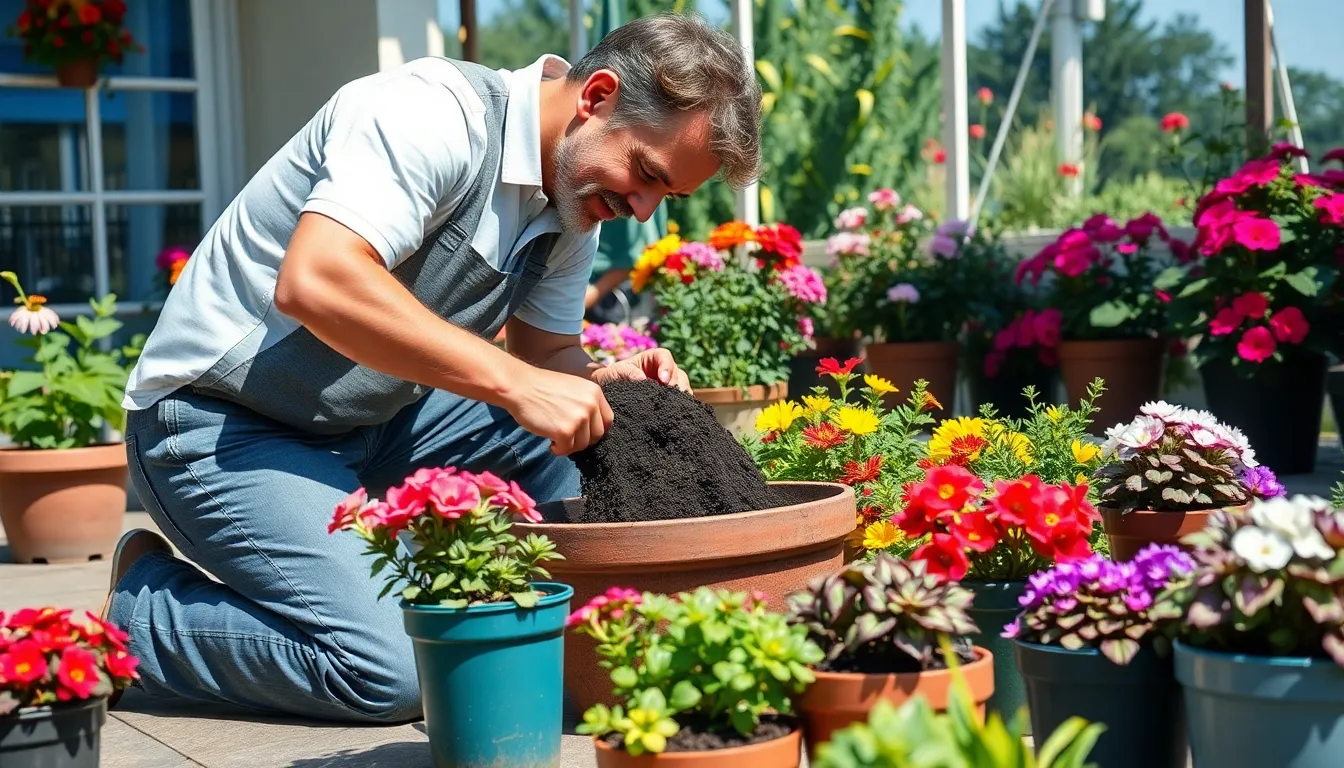
Creating the right foundation for your outdoor container plants starts with selecting quality potting soil that provides both moisture retention and proper drainage. We recommend using fresh, commercial potting mixes that contain organic matter and essential nutrients, rather than backyard soil which often lacks these critical components.
Use Well-Draining Soil Combinations
Drainage becomes the most critical factor when selecting potting combinations for outdoor containers. We ensure our potting mix drains effectively to prevent waterlogging, which causes root rot in container plants. Water should flow freely through the soil when we saturate pots completely, with excess moisture draining from the bottom holes.
Testing drainage involves watering until we observe water flowing from drainage holes, confirming that moisture reaches the deepest root zones. Avoid adding mulch to densely planted containers, as this can impede proper aeration and drainage. Decorative pebbles work better for hiding bare soil surfaces while maintaining the soil’s ability to breathe and drain properly.
Add Slow-Release Fertilizers
Balanced, time-released granular fertilizers provide steady nutrition over several months when incorporated into potting mix at planting time. Container plants typically require more frequent feeding than ground-planted varieties since they’re heavy feeders with limited soil volume. We mix slow-release fertilizer directly into the potting medium to ensure consistent nutrient availability.
Supplemental feeding becomes necessary about one month after initial planting. We apply half-strength water-soluble fertilizer every 2-3 weeks during the growing season to maintain optimal nutrient levels. This dual approach of slow-release base nutrition plus regular liquid feeding keeps outdoor potted plants thriving throughout their growing period.
Ensure Proper pH Levels
Selecting potting mixes appropriate for exact plant species generally provides suitable pH ranges for most outdoor container plants. We choose specialized formulations like cactus and succulent mixes when growing plants with exact soil requirements. Testing soil pH allows for more precise control when growing pH-sensitive plants in containers.
Amendments become necessary when soil tests reveal pH levels outside our plants’ preferred ranges. We add lime to raise pH for plants preferring alkaline conditions, or incorporate sulfur to lower pH for acid-loving species. Most commercial potting mixes maintain neutral to slightly acidic pH levels that suit the majority of outdoor container plants.
Position Your Potted Plants for Optimal Growth
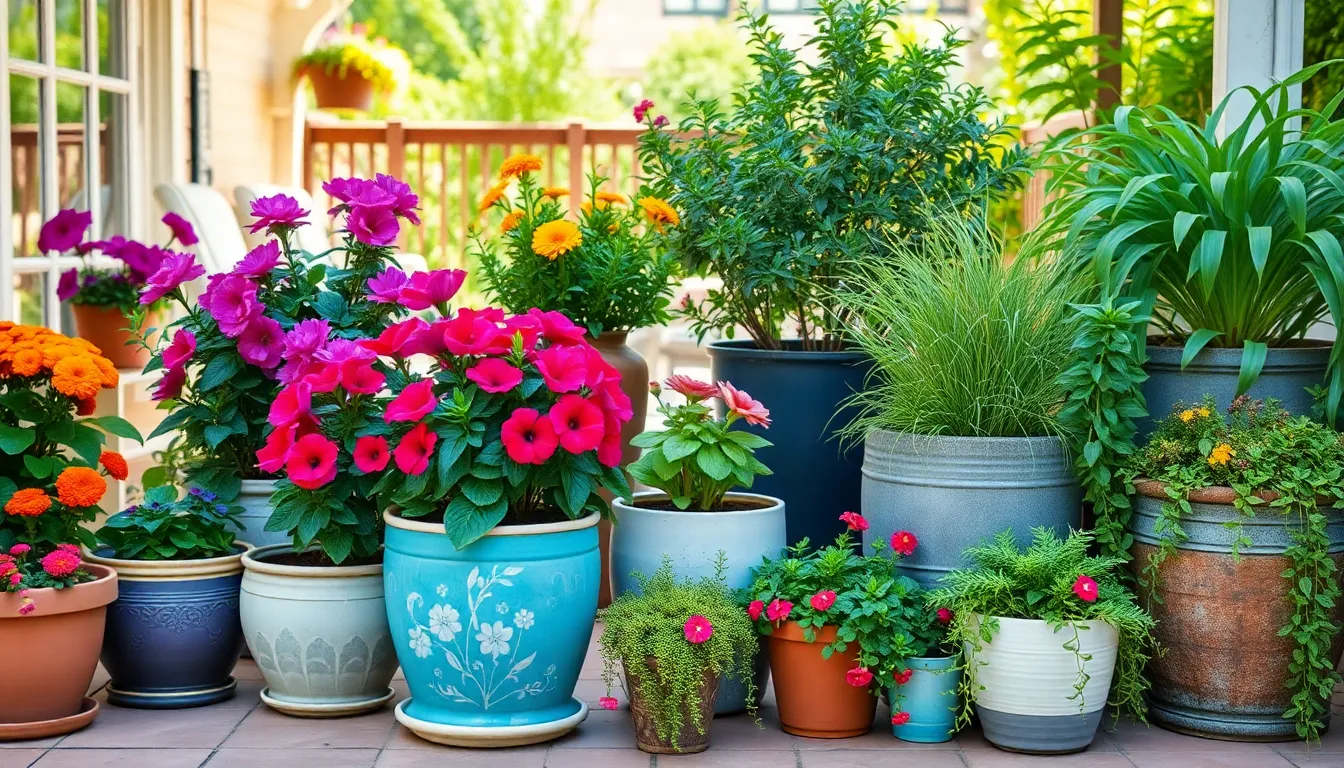
Now that you’ve chosen your containers, plants, and soil, strategic positioning becomes crucial for creating thriving outdoor displays. Proper placement considers both plant health requirements and visual appeal to maximize your container garden’s success.
Assess Sunlight Requirements
Match plants to sunlight exposure by placing sun-loving varieties in full sun spots and shade-tolerant ones in shadier locations. We recommend observing your outdoor space throughout the day to identify which areas receive direct sunlight and which remain partially shaded.
Account for heat and seasonal light changes when selecting your plant locations. Choose plants suited to your climate’s sun exposure patterns, keeping in mind that light intensity and duration shift with the seasons.
Group plants with similar light needs together to simplify maintenance and promote healthier growth. This strategic clustering allows us to water and care for plants with comparable requirements more efficiently.
Plan for Seasonal Changes
Prepare to move pots as sunlight patterns change throughout the year, or swap out plants for seasonal varieties to maintain healthy growth year-round. Container gardening’s mobility advantage shines during seasonal transitions.
Use fertilizers like time-release pellets or diluted fish emulsion to supplement nutrients and support seasonal growth cycles. We find that consistent fertilization becomes especially important as plants face changing environmental conditions.
Position containers near water sources for easier maintenance during seasonal care routines. Locating pots close to irrigation points or watering areas simplifies the increased attention plants may need during weather transitions.
Create Attractive Groupings
Use layering and plant height for depth by arranging taller plants at the back or center, medium plants in the middle, and trailing plants at the front or edges. This “thriller, filler, spiller” approach adds dimension and visual interest to your displays.
Group planters in odd numbers for optimal visual appeal, with triplets or groups of three working particularly well. But, four containers or a single statement planter can also prove effective depending on your available space.
Arrange plants logically within pots using formations like semi-circles, squares, or checkerboard patterns to maximize space and aesthetics. Leave 1-2 inches between plant roots and pot edges to allow room for root expansion.
Use pots to create privacy or separate outdoor spaces by positioning containers as living dividers or traffic guides. We can strategically place larger containers to mark walkways, edges, or focal points while adding functional beauty to our outdoor areas.
Establish a Consistent Watering Schedule
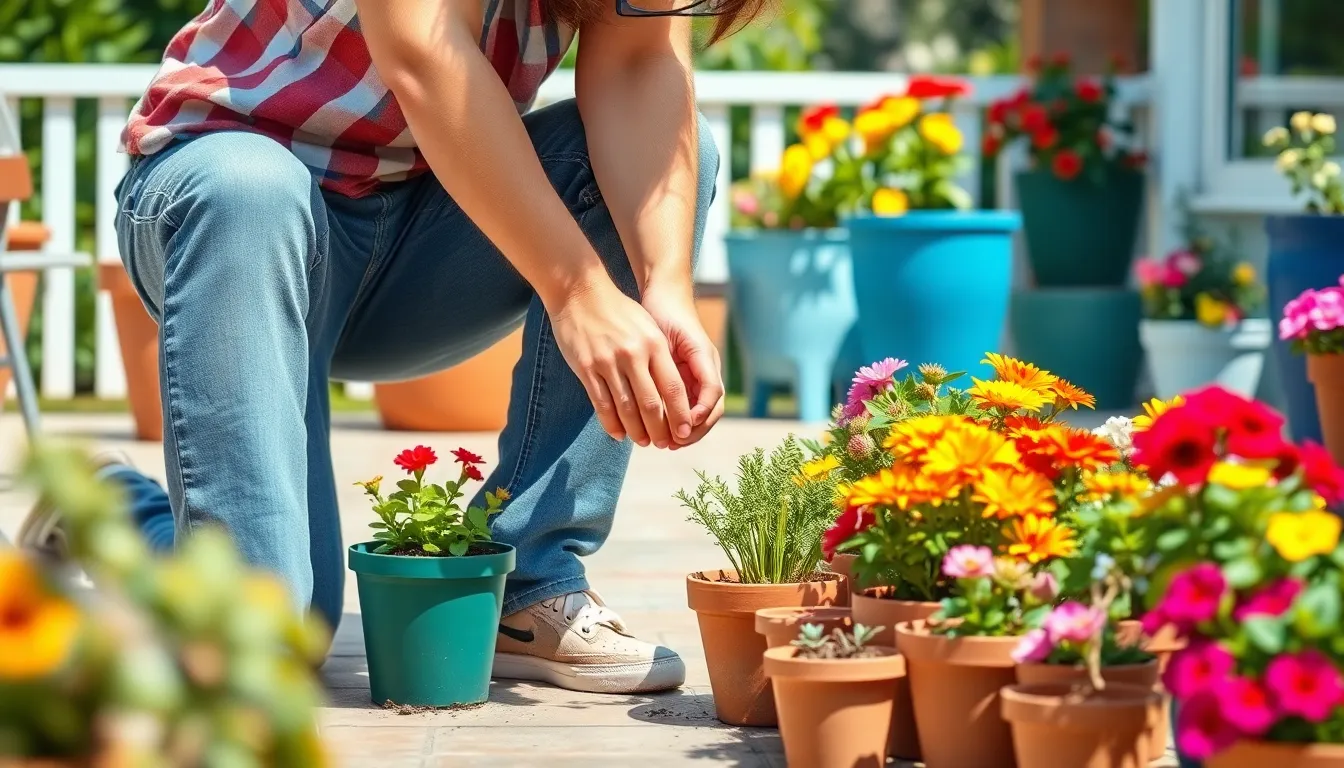
Maintaining healthy outdoor potted plants requires developing a systematic approach to watering that adapts to changing conditions. We’ll explore effective strategies for monitoring moisture levels and adjusting our watering practices throughout the growing season.
Monitor Soil Moisture Levels Daily
Daily monitoring becomes essential for successful container gardening since potted plants dry out faster than ground plantings. We should check the top inch of soil each morning, watering when it feels dry to the touch. Plant symptoms like shriveled leaves, limp stems, dropping petals, or dry discolored foliage signal immediate watering needs.
Establishing our watering routine for early morning or late evening prevents evaporation losses and ensures optimal water absorption. Small containers often require twice daily watering during hot weather periods, while larger pots maintain moisture longer. Consistency in our monitoring schedule helps us recognize each plant’s exact moisture requirements over time.
Adjust Frequency Based on Weather
Weather conditions directly impact how often we need to water our outdoor containers. Spring watering typically occurs every 3 to 4 days, but summer heat increases this frequency to daily or even twice daily for smaller pots. Hot, dry weather accelerates moisture loss since containers retain less water than ground soil.
Cool or rainy periods require reduced watering frequency to prevent root rot and fungal problems from developing. We should decrease watering during overcast days or when rain provides natural moisture. Newly planted trees and shrubs need daily watering for their first two weeks, then we gradually reduce to twice or thrice weekly over several months until they establish strong root systems.
Install Drip Irrigation Systems
Drip irrigation systems deliver water slowly and directly to the soil, maintaining consistent moisture levels while reducing waste. These automated systems prevent wet foliage that encourages disease development and support precise watering schedules aligned with plant needs. We can program drip systems to adjust automatically based on weather changes and exact plant requirements.
Installing drip irrigation becomes particularly valuable for larger container collections or when we travel frequently. The system ensures plants receive adequate hydration without water stress while minimizing our daily maintenance responsibilities. Consistent moisture delivery through drip irrigation promotes healthier root development and more vigorous plant growth throughout the growing season.
Maintain Your Outside Plants in Pots Throughout the Seasons
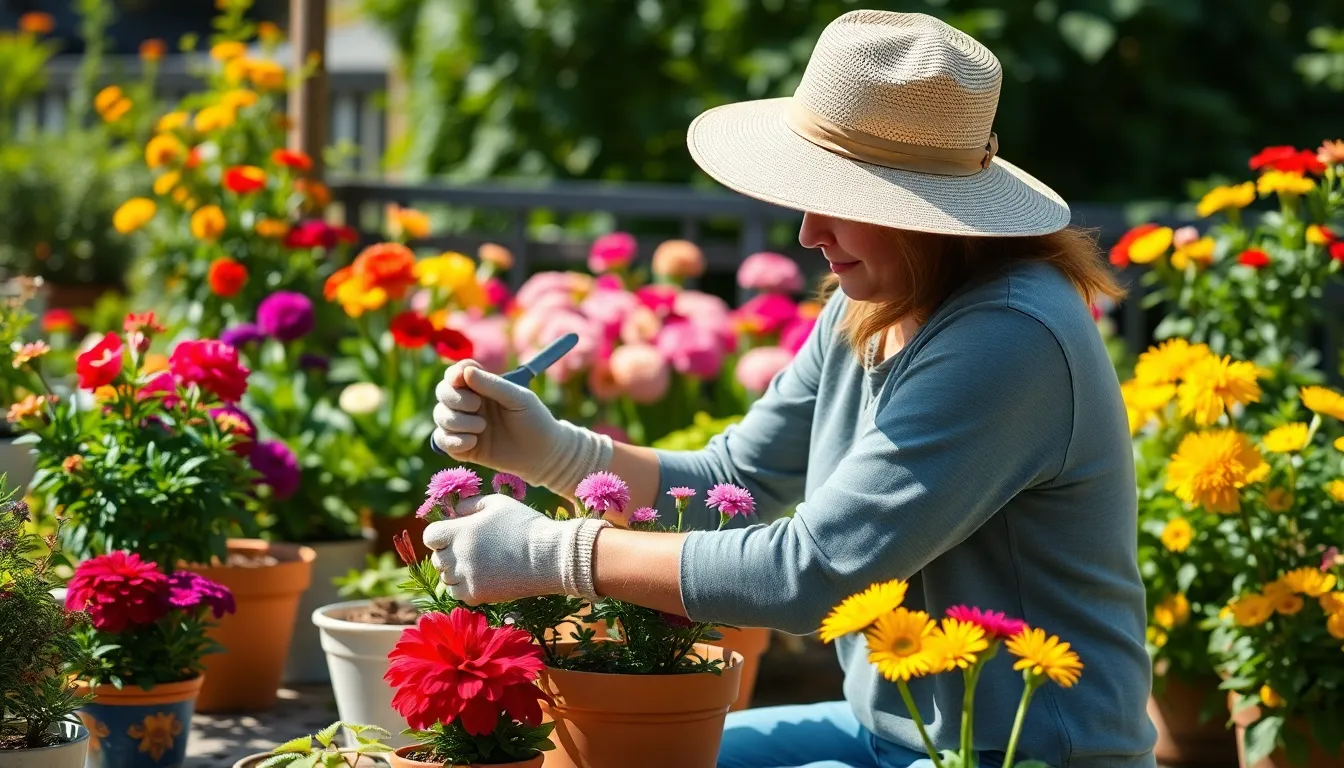
Seasonal maintenance keeps our outdoor potted plants healthy and productive year-round. We’ll need to adjust our care routines as conditions change to ensure continuous growth and vibrant displays.
Prune and Deadhead Regularly
Regular pruning shapes our plants while removing dead or diseased growth that can harbor pests and diseases. We should focus on cutting back overgrown branches to maintain the desired form and encourage bushier growth patterns.
Deadheading spent flowers prevents seed formation and promotes continuous flowering throughout the growing season. We can simply pinch off faded blooms with our fingers or use clean pruning shears for thicker stems.
Timing matters when we prune our container plants. Spring offers the best opportunity for major pruning before new growth begins, while light maintenance pruning can continue throughout the growing season.
Disease prevention becomes easier when we remove problematic growth immediately. We’ll want to dispose of diseased plant material in regular trash rather than composting it to prevent spreading issues to healthy plants.
Fertilize on Schedule
Container plants require consistent feeding since their soil volume is limited and often low in nutrients. We should use a balanced, time-released granular fertilizer mixed into the potting soil at planting to provide slow nutrients over several months.
Supplemental feeding becomes necessary about a month after planting. We’ll need to apply a half-strength water-soluble fertilizer every two to three weeks during the growing season to meet our plants’ heavy feeding needs.
Flowering and fruiting plants benefit from monthly feeding with diluted liquid fertilizer applied to moist soil. We should always water our containers before applying liquid fertilizers to prevent root burn and ensure proper nutrient uptake.
Growing season demands change as temperatures fluctuate. We can reduce feeding frequency during cooler months when plant growth naturally slows, then resume regular feeding schedules as spring warmth returns.
Repot When Necessary
Repotting every 1-2 years provides fresh soil and more space for roots to grow. We should plan this task for spring when plants are beginning their active growing phase and can recover quickly from transplant stress.
Fresh soil renewal offers benefits even when we don’t need larger containers. We can gently remove the top 2 inches of old compost annually and replace it with fresh compost mixed with slow-release fertilizer.
Root bound plants show clear signs that indicate repotting time. We’ll notice roots circling the pot’s bottom, water running straight through without absorption, or stunted growth even though proper care.
Container size selection requires careful consideration during repotting. We should choose pots slightly larger than the current root ball, avoiding containers that are too large since excess soil may retain too much moisture and lead to root problems.
Mulching our newly repotted plants helps retain moisture and improves soil health. We can apply a thin layer of organic mulch around plants, keeping it away from stems to prevent pest and disease issues.
Protect Container Plants from Weather Extremes
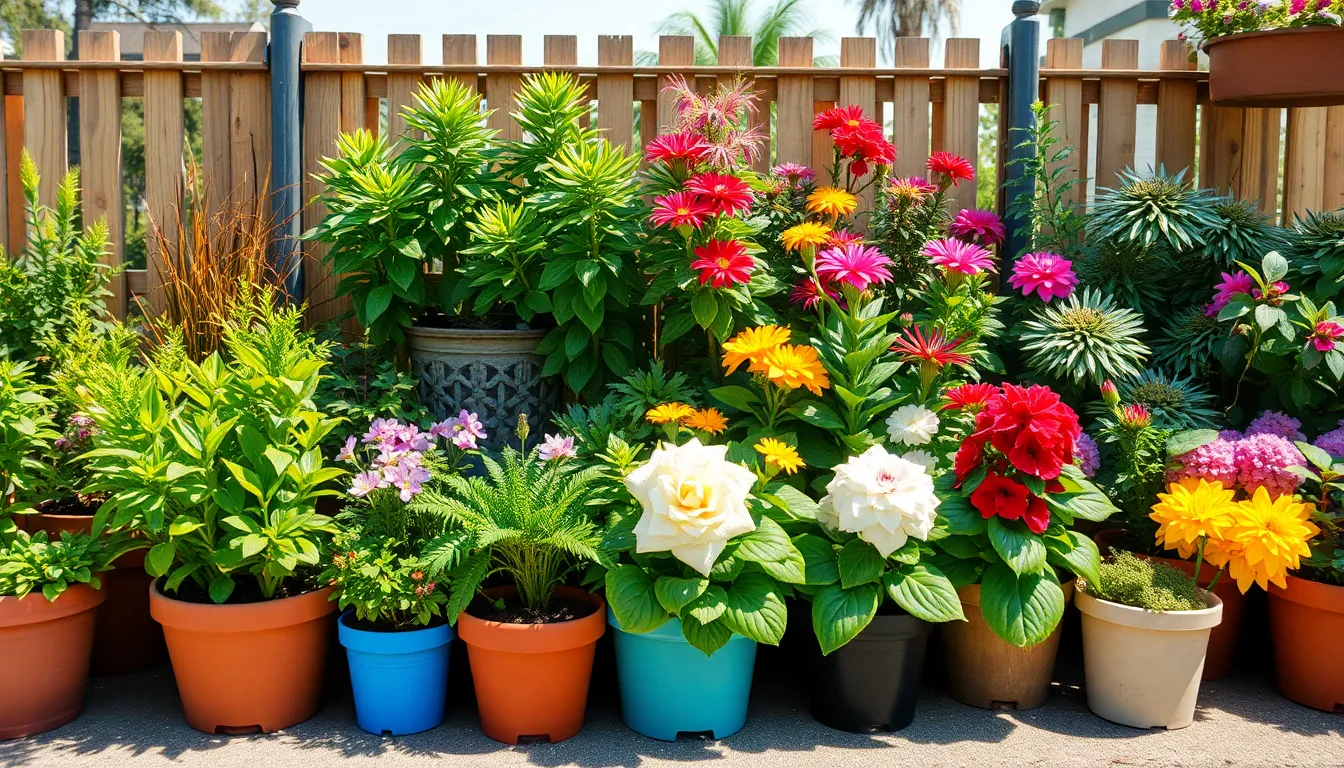
Weather extremes pose unique challenges for container gardening, as potted plants are more vulnerable than their ground-planted counterparts. We’ll share proven strategies to safeguard your outdoor containers through every season.
Shield from Strong Winds
Strong winds dry out soil rapidly and cause physical damage to plants and containers. Grouping pots together creates a protective microclimate that reduces wind impact while helping retain essential soil moisture. We recommend placing containers close to each other, as this natural windbreak also minimizes heat stress exposure.
Position your heaviest containers as anchors against lighter pots to prevent toppling during gusty conditions. Use the shelter of walls, fences, or larger structures to create additional wind protection zones. Staking tall plants provides extra stability when strong winds are forecasted for your area.
Provide Winter Protection
Winter temperatures threaten container plants more severely than ground plantings since pots offer less natural insulation than soil. Wrapping containers with insulating materials like bubble wrap, old blankets, burlap, or towels keeps root systems warm during freezing periods.
Burying pots directly in the ground or mulching heavily around containers with 6 to 12 inches of wood chips, straw, or leaves utilizes the earth’s natural insulation properties. We suggest using thermal blankets or frost cloth to cover entire containers once temperatures drop to 25 to 30°F, preventing extreme cold damage to both roots and foliage.
Grouping containers together in sheltered locations and covering them with mulch creates additional protection from temperature swings. Building straw bale fences around grouped pots reduces wind exposure while trapping warmer air around plants. Gradually removing winter protection in spring allows plants to acclimate naturally to warming conditions.
Prevent Heat Stress in Summer
Summer heat causes rapid soil drying and places important stress on container plants requiring increased attention to watering and cooling strategies. Watering containers thoroughly in early morning and evening maintains consistent moisture levels when temperatures peak during midday hours.
Applying organic mulch like straw or wood chips around plants conserves soil moisture, reduces evaporation, and keeps root zones cooler throughout hot days. We recommend placing containers in partial shade during the hottest parts of summer or using shade cloths and umbrellas to filter intense sunlight.
Regular fertilizing with balanced, slow release fertilizer meets the increased nutrient demands that plants experience during heat stress periods. Moving portable containers to shadier locations during extreme heat waves provides temporary relief while maintaining plant health through challenging weather conditions.
Design Beautiful Arrangements with Potted Plants
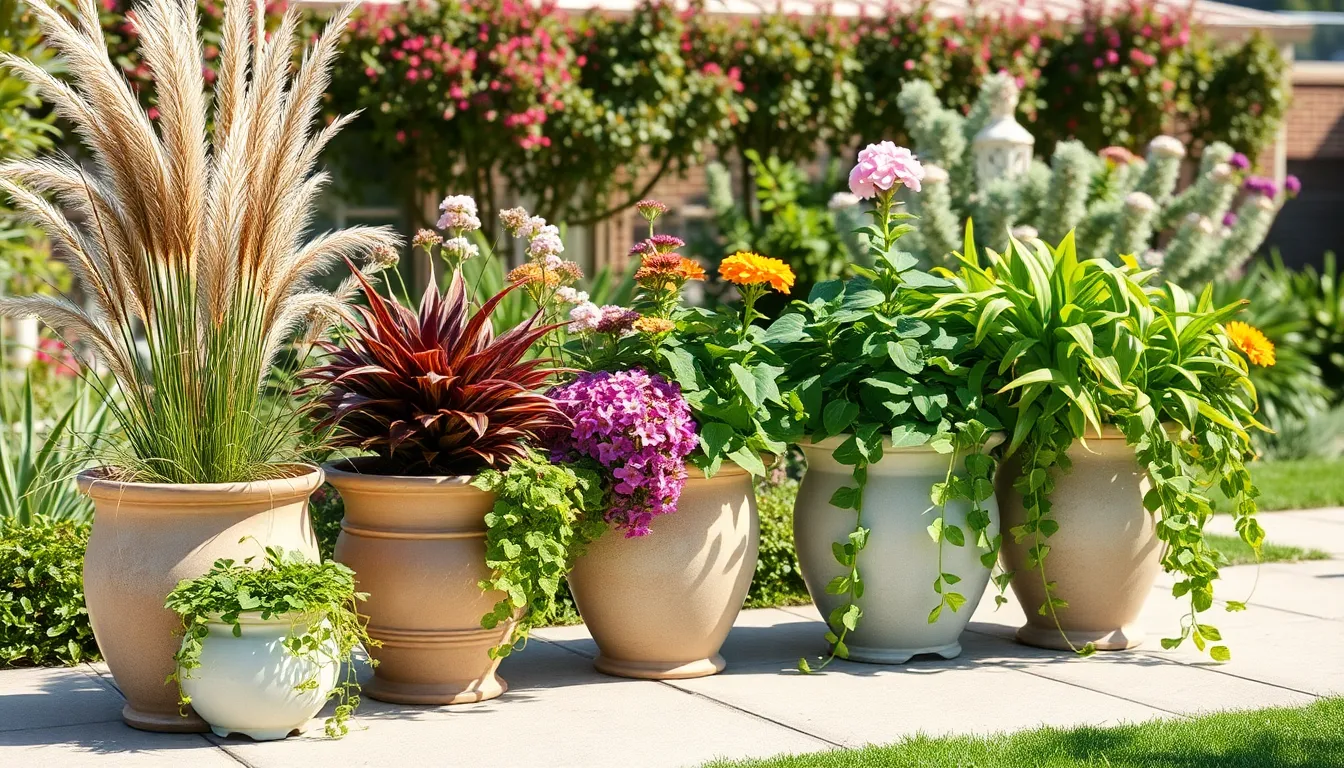
Creating stunning container displays requires strategic planning that combines visual design principles with practical growing considerations. We’ll transform ordinary potted plants into eye-catching focal points by mastering three essential techniques.
Layer Plants by Height and Texture
Architectural layering forms the foundation of professional-looking container arrangements. We recommend adding a “spike” plant or tall ornamental feature to create dramatic vertical interest at the center or back of your display. Medium-height plants with varying leaf textures fill the middle layer, providing visual depth and complexity throughout the growing season.
Trailing plants complete our layered approach by draping gracefully over pot edges to soften hard container lines. We ensure proper proportions by selecting tallest plants that measure approximately twice the height of the visible container portion. Large specimens in small pots create visual imbalance, while tiny plants in oversized containers appear lost and insignificant.
Textural contrasts between smooth, glossy leaves and rough, serrated foliage add sophisticated appeal to our arrangements. We combine plants with different growth habits like upright grasses with mounding flowers to maximize visual impact from multiple viewing angles.
Choose Complementary Colors
Color harmony prevents flat, uninspiring container displays that lack visual punch. We select flower and foliage colors that complement rather than compete with each other, creating richness through thoughtful combinations. Mixing burgundy foliage with golden blooms produces striking contrast, while pairing silver leaves with purple flowers creates elegant sophistication.
Positioning becomes crucial when arranging colorful displays that we’ll view from different angles throughout the day. We place our brightest colors where they’ll catch the most light and create maximum visual impact from primary viewing areas. Cool blues and purples work beautifully in shadier spots, while warm reds and oranges shine in sunny locations.
Foliage colors provide lasting appeal when flowers fade between bloom cycles. We incorporate plants with colorful leaves like coleus, caladiums, or ornamental kale to maintain visual interest throughout changing seasons.
Create Year-Round Interest
Seasonal variety ensures our container gardens remain attractive beyond single bloom periods. We include plants with staggered flowering times so different specimens peak at various points throughout the growing season. Long-blooming flowers combined with diverse foliage textures provide continuous color and visual appeal.
Container size directly impacts our plants’ ability to thrive year-round in their restricted root space. We choose appropriately sized pots that accommodate root systems without becoming cramped or waterlogged during different weather conditions.
Foliage plants carry our design through periods when flowers aren’t in bloom, providing consistent color and texture. We select evergreen options like dwarf conifers or broadleaf plants that maintain their appearance through temperature fluctuations and seasonal transitions.
Troubleshoot Common Problems with Container Gardens
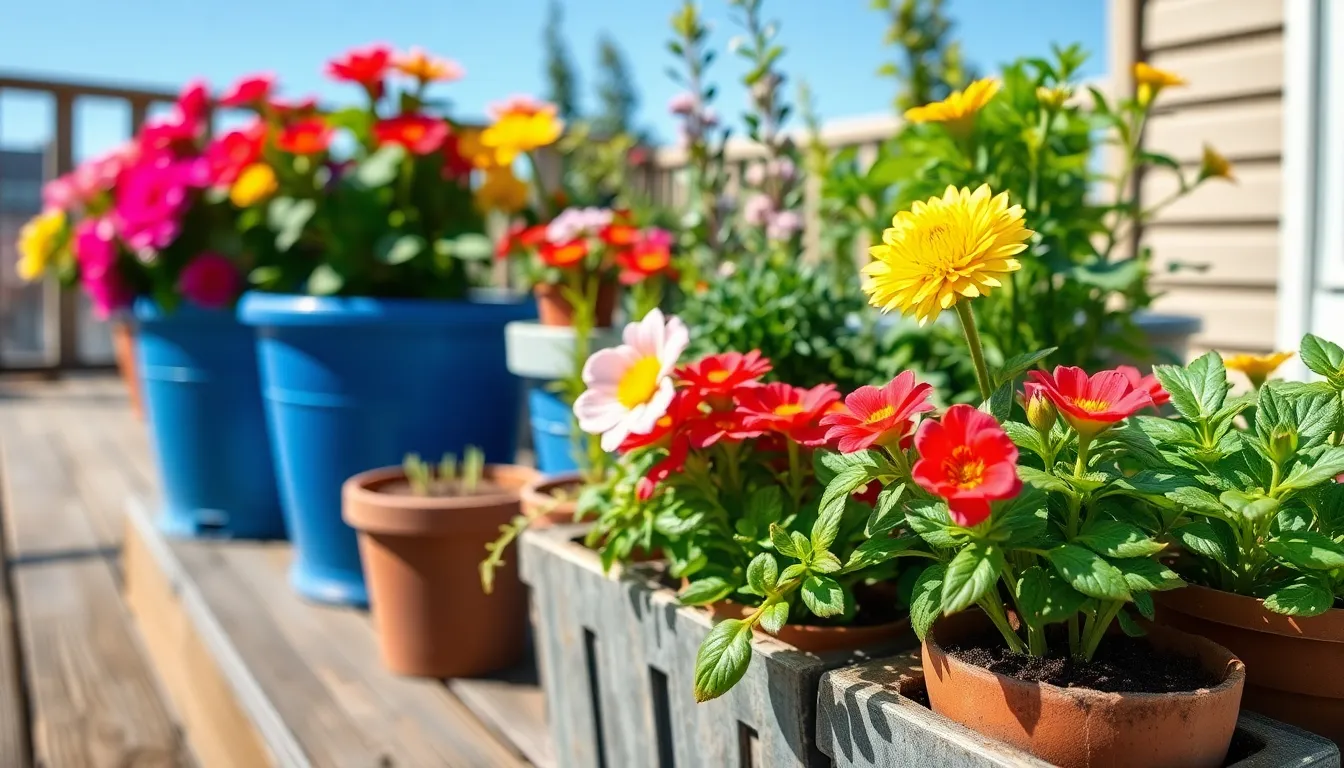
Even with proper planning, container gardens face unique challenges that require quick identification and targeted answers. Let’s address the most common issues that can affect our potted plants’ health and productivity.
Address Pest and Disease Issues
Pests like aphids and spider mites target container plants more aggressively due to their concentrated environment. We recommend using insecticidal soaps or introducing natural predators to control these infestations without harming beneficial insects.
Overcrowded containers create perfect conditions for diseases to spread rapidly. Air circulation becomes restricted when we pack too many plants together, leading to fungal and bacterial problems that can devastate entire containers.
Water at the base of plants rather than overhead to prevent foliage diseases from taking hold. Overhead watering creates moist conditions on leaves that encourage fungal growth and bacterial infections.
Remove diseased plant material immediately to prevent spread to healthy plants. Prompt action stops minor issues from becoming major problems that could affect our entire container garden.
Space containers adequately to improve airflow between plants and reduce humidity levels around foliage. Better air circulation naturally decreases the likelihood of disease development and pest infestations.
Solve Drainage Problems
Drainage holes are absolutely essential for healthy container plants, as standing water leads to root rot and fungal diseases. We must ensure every pot has multiple holes in the bottom to allow excess water to escape freely.
Drill additional holes in containers that lack proper drainage, as most decorative pots come without adequate openings. Make several holes at least half an inch in diameter to prevent clogging from soil particles.
Use well-draining potting mix instead of garden soil, which retains too much moisture and becomes compacted in containers. Quality potting mixes contain materials like perlite and vermiculite that promote proper water flow.
Avoid letting pots sit in standing water, even in saucers, as this negates the benefits of drainage holes. Empty saucers within an hour of watering to prevent water from being reabsorbed into the soil.
Consider pot materials when planning drainage, as terracotta naturally wicks moisture away from soil while plastic retains more water. Match your watering schedule to the container material’s characteristics for optimal plant health.
Fix Nutrient Deficiencies
Container plants depend entirely on the nutrients we provide since they can’t access soil beyond their pots. Potting mix nutrients deplete quickly, requiring regular supplementation throughout the growing season.
Monitor plants for yellowing leaves, stunted growth, or poor flowering, which indicate nutrient deficiencies developing. Early detection allows us to correct problems before they seriously impact plant health and productivity.
Use balanced fertilizers specifically formulated for container plants, as these provide the right nutrient ratios for confined growing conditions. Regular garden fertilizers may not address the unique needs of potted plants.
Apply fertilizer according to package directions during active growing periods, typically from spring through early fall. Container plants often need more frequent feeding than ground planted specimens due to limited soil volume.
Test soil pH periodically to ensure nutrients remain available to plant roots. Nutrient lockout occurs when soil becomes too acidic or alkaline, preventing plants from absorbing even abundant nutrients.
Maximize Space with Creative Container Solutions
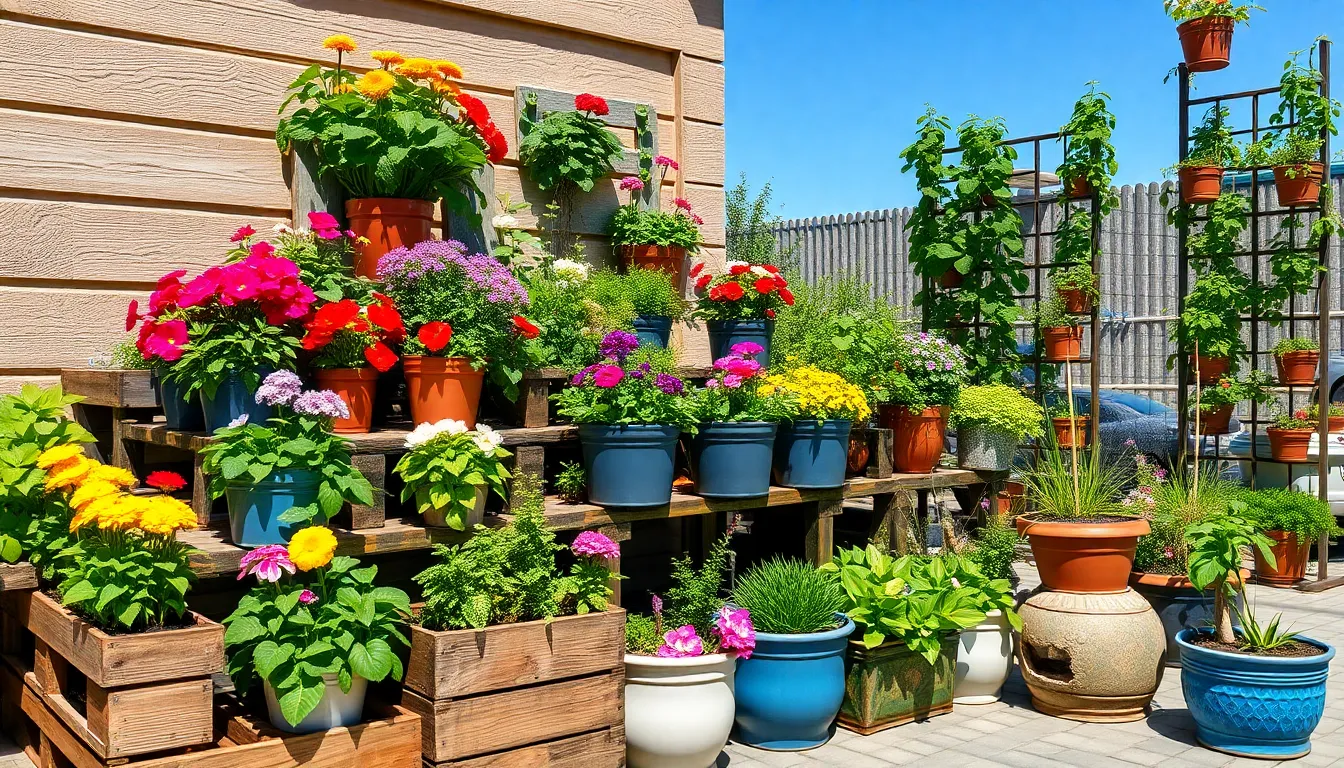
Container gardening offers endless possibilities for maximizing our outdoor growing potential, even in the smallest spaces. We can transform any area into a productive garden by thinking creatively about how we use vertical space and repurpose everyday items.
Use Vertical Growing Techniques
Vertical growing techniques dramatically increase our planting capacity without requiring additional ground space. Wall-mounted planters allow us to create living walls that transform bare surfaces into productive growing areas. Stackable containers provide multiple growing levels while maintaining easy access for maintenance and harvesting.
Climbing plants such as pole beans, cucumbers, and vining tomatoes thrive on trellises and vertical structures we install against walls or fences. Modular wall systems accommodate compact herbs, lettuce, and strawberries in pocket-style planters that maximize every square inch of available space.
Repurposed pallets become excellent vertical planters when we add industry fabric and fill the spaces with potting mix. Hanging shoe organizers offer economical answers for growing herbs and small vegetables vertically, making previously unused wall space highly productive.
Carry out Tiered Displays
Tiered displays create multi-level visual interest while optimizing our use of horizontal space. We arrange tall plants like dwarf fruit trees or ornamental grasses in the back tier to provide height and structure. Medium-height plants such as peppers and compact tomatoes fill the middle tier, creating balanced proportions.
Trailing plants like cherry tomatoes and cascading herbs work beautifully in the front tier, where they can spill over container edges. Plant stands and risers help us achieve these layered effects while ensuring each plant receives adequate sunlight exposure.
Tiered shelving systems allow us to display multiple containers at varying heights, maximizing both growing space and visual appeal. We position containers strategically so taller plants don’t shade shorter ones, ensuring optimal growing conditions throughout our tiered arrangement.
Repurpose Unique Containers
Unique container answers transform everyday objects into functional growing spaces while reducing waste and costs. Old compost bins provide excellent large-scale growing containers for root vegetables and sprawling plants. Cement blocks create modular raised bed systems that we can configure in countless arrangements.
Mailboxes and toolboxes offer weatherproof containers perfect for herb gardens and compact vegetables. Half-whiskey barrels provide substantial growing space for larger plants while adding rustic charm to our outdoor spaces.
Grow bags present lightweight, versatile options that we can place virtually anywhere in our garden setup. These fabric containers promote excellent root health through superior drainage and air circulation, making them ideal for vegetables and flowers alike.
Birdbaths and large serving bowls become unique planters for shallow-rooted plants and succulents, adding unexpected elements to our container garden displays.
Conclusion
We’ve covered everything you need to transform your outdoor space with beautiful potted plants. From selecting the perfect containers to mastering watering schedules and seasonal care, you now have the tools to create stunning displays that thrive year-round.
Container gardening opens endless possibilities for creativity and functionality. Whether you’re working with limited space or want the flexibility to redesign your garden layout, potted plants offer the perfect solution.
Remember that success comes from matching your plant choices to your exact conditions and maintaining consistent care routines. With these strategies in place, you’ll enjoy a vibrant outdoor oasis that brings joy and natural beauty to your home.
Start small, experiment with different combinations, and watch your confidence grow alongside your plants. Your journey into container gardening begins now.
Frequently Asked Questions
What are the main advantages of container gardening?
Container gardening offers exceptional flexibility and adaptability for any outdoor space, from small balconies to large patios. It allows easy movement and protection of plants from harsh weather conditions, making it perfect for renters and urban dwellers who can’t plant directly in the ground.
What should I look for when choosing containers for outdoor plants?
Select containers with multiple drainage holes to prevent root rot. Choose appropriate size and lightweight materials for elevated spaces. Ensure containers are weather-resistant with frost-resistant and UV-treated materials for longevity. Match container size to your plant’s mature size and root system needs.
Which plants work best for container gardening?
Choose plants that thrive in limited soil volume and match your local climate conditions. Consider dwarf varieties of vegetables, herbs, flowering annuals, and compact perennials. Ensure plants have similar water and sunlight requirements when grouping containers together for easier maintenance.
How do I create an attractive container garden arrangement?
Use layering techniques by arranging plants by height and texture. Group containers in odd numbers for visual appeal. Choose complementary colors for harmony and include evergreen plants for year-round interest. Position taller plants in back with shorter ones in front.
What’s the best watering schedule for potted plants?
Establish a consistent watering schedule based on plant needs and weather conditions. Check soil moisture daily during hot weather. Most container plants need watering when the top inch of soil feels dry. Adjust frequency seasonally and ensure proper drainage to prevent overwatering.
How can I protect my container plants from weather extremes?
Move portable containers to sheltered areas during storms or extreme temperatures. Use frost cloths for cold protection and provide shade during intense heat. Group containers together for insulation and consider bringing tender plants indoors during harsh weather conditions.
What are common container gardening problems and solutions?
Common issues include pest infestations, drainage problems, and nutrient deficiencies. Control pests with regular inspection and appropriate treatments. Ensure proper drainage with holes and quality potting mix. Address nutrient deficiencies with balanced fertilizers designed for container plants and regular feeding schedules.
How can I maximize space in small container gardens?
Use vertical growing techniques with wall-mounted planters and stackable containers. Install trellises for climbing plants and create tiered displays for optimal sunlight exposure. Repurpose unique containers like old bins or birdbaths to create functional growing spaces while maximizing planting capacity.

